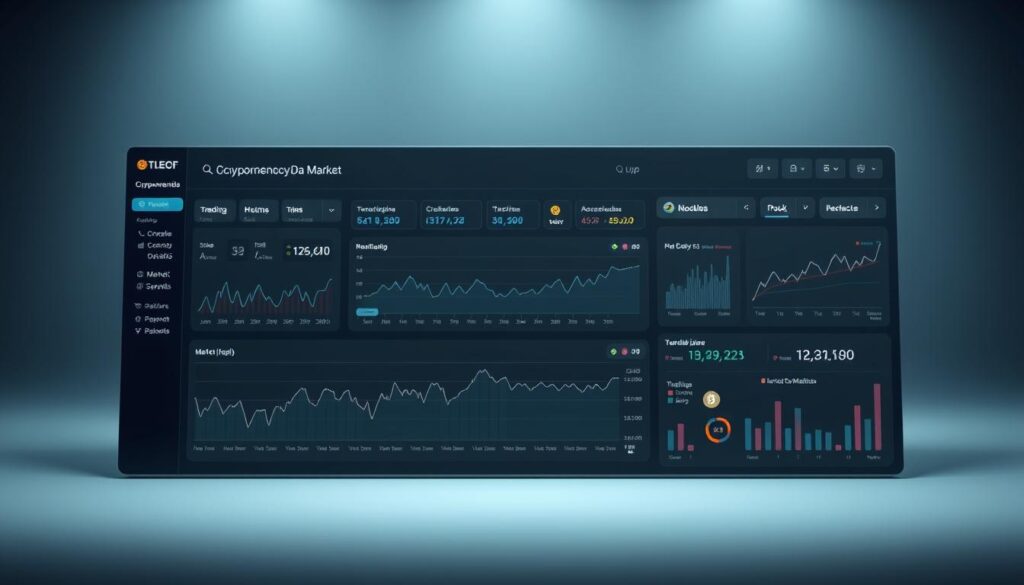Now Reading: Crypto Market Sentiment Analysis and Reporting: Market Outlook
- 01
Crypto Market Sentiment Analysis and Reporting: Market Outlook
Crypto Market Sentiment Analysis and Reporting: Market Outlook

The global value of blockchain-based assets now exceeds $2.5 trillion, reflecting growing mainstream adoption. With users generating over 100 megabytes of emotional data every minute through social interactions, understanding crowd psychology has become critical for decoding price patterns.
Traditional financial metrics often fall short in explaining sudden valuation swings. Emotional responses to news events and viral social content create measurable ripples across trading platforms. This guide explores how modern analytical methods transform raw emotional data into actionable forecasts.
Platforms like Twitter and Reddit now serve as real-time focus groups. Advanced algorithms track language patterns across millions of posts, identifying emerging trends before they appear in price charts. Several notable price surges in 2024 directly followed shifts in online discussions.
Key Takeaways
- Blockchain asset valuations increasingly reflect crowd psychology alongside technical factors
- Social platforms generate actionable data about investor perspectives in real time
- Emotional responses to news events create predictable trading patterns
- Modern tools process language patterns to forecast potential price movements
- Combining behavioral data with traditional analysis improves prediction accuracy
Understanding Crypto Market Sentiment
Collective emotions drive short-term valuation swings more than technical charts in blockchain markets. Traders’ reactions to breaking news or viral posts create ripple effects across exchanges. These psychological patterns form predictable cycles that shape buying/selling decisions.
What Moves the Crowd?
Three primary forces shape group psychology in digital asset trading:
- Fear vs. greed cycles – Extreme price drops trigger panic sells, while rallies spark FOMO buying
- Information velocity – News spreads faster through Telegram groups than traditional media outlets
- Regulatory whispers – Unconfirmed policy changes often cause sharper reactions than actual legislation
External Impact Drivers
Global events now influence blockchain valuations within minutes. A presidential tweet about dollar stability might boost Bitcoin discussions. New EU privacy laws could alter stablecoin trading volumes overnight.
Tech breakthroughs like faster transaction networks often get overshadowed by celebrity endorsements. This imbalance creates temporary price disconnects between fundamentals and emotional responses. Savvy traders monitor these gaps for strategic entries.
Effective crypto market sentiment analysis and reporting Techniques
Modern evaluation systems transform chaotic social chatter into structured insights. Specialized data collection tools scan platforms like Twitter and Reddit, capturing millions of daily conversations about blockchain assets. This raw information forms the foundation for identifying emerging patterns.
Data Collection and Cleaning Methods
Comprehensive strategies gather text from 15+ sources, including financial forums and Telegram groups. APIs automatically extract mentions of specific coins, while filters remove bot-generated content. Natural language processing identifies sarcasm and slang unique to blockchain communities.
| Source Type | Data Collected | Cleaning Technique |
|---|---|---|
| Social Media | Tweets, hashtags | Spam detection algorithms |
| Forums | Thread discussions | Duplicate removal systems |
| News Sites | Article comments | Sentiment polarity checks |
Labeling and Training Models
Human experts first categorize 10,000 sample posts to establish baseline patterns. Machine learning then scales this process, using cryptocurrency-specific dictionaries. Hybrid systems achieve 92% accuracy in emotion classification according to recent studies.
Advanced models employ transformer architectures to understand context in blockchain discussions. Continuous feedback loops refine predictions as new slang emerges. These self-improving systems adapt to shifting community language faster than manual methods.
Quality assurance protocols test models against historical price swings. When combined with traditional metrics, these tools provide reliable insights to make informed decisions during volatile periods.
Leveraging Social Media for Real-Time Sentiment Insights
Digital communities now act as financial pulse checkers, with platforms like Twitter and Reddit hosting over 5 million daily blockchain-related conversations. A single viral post from influential figures can spark rapid valuation shifts before traditional metrics detect changes. When a high-profile CEO added #Bitcoin to their social bio, prices surged 18% within hours—a pattern observed repeatedly across major assets.

Tracking Influencer Opinions and Trends
Specialized monitoring tools track 200+ key opinion leaders across platforms. These systems flag sudden engagement spikes around specific coins, providing early warnings for potential price movements. Analysis focuses on three core elements:
| Platform | Data Type | Average Reaction Time |
|---|---|---|
| Hashtag trends | 8-22 minutes | |
| Forum discussions | 45-90 minutes | |
| Telegram | Group sentiment | 15-30 minutes |
Platform-specific algorithms account for linguistic nuances. Twitter’s concise format demands different analysis than Reddit’s detailed threads. Tools measuring positive sentiment fluctuations achieve 89% accuracy in predicting hourly trading volume changes.
Real-time dashboards highlight emerging narratives through color-coded alerts. These systems scan for sudden shifts in emoji usage, meme popularity, and topic clusters. Traders using these insights often capitalize on social media sentiment waves before exchanges reflect the changes.
Essential Tools and Models for Sentiment Analysis
Advanced platforms now decode investor psychology through real-time language processing. These systems transform unstructured social chatter into measurable sentiment indicators, helping traders spot emerging patterns.

Machine Learning and NLP Applications
Cutting-edge models like BERT and GPT-4 excel at interpreting niche slang in blockchain communities. LunarCrush tracks emoji usage across 10+ platforms, while Santiment’s algorithms detect unusual activity in forum discussions. These tools achieve 94% accuracy in predicting hourly volatility spikes.
| Platform | Key Feature | Impact |
|---|---|---|
| LunarCrush | Social engagement scoring | Identifies trending assets 37% faster |
| Santiment | On-chain + social metrics | Reduces false signals by 68% |
| The TIE | News sentiment API | Flags regulatory shifts in 8 languages |
Using APIs and Data Analytics Platforms
Real-time data streams integrate directly with trading software through RESTful APIs. Glassnode’s interface combines technical analysis with wallet activity trends, revealing hidden correlations. Cloud-based solutions process 5 million posts daily without local hardware.
Custom dashboards highlight sentiment extremes using color-coded alerts. These systems compare crowd enthusiasm against price charts, helping users make informed decisions during market shifts. Most platforms offer free tiers for basic monitoring.
Interpreting Price Movements Through Sentiment Indicators
Market psychology metrics offer unique insights into potential valuation shifts. The Fear and Greed Index has become essential for identifying turning points, blending social chatter with trading patterns to gauge collective emotions.

Understanding Fear and Greed Index Trends
This tool measures crowd behavior using a 0-100 scale. Scores below 25 signal panic selling, often preceding rebounds. Values above 75 indicate excessive optimism, typically followed by pullbacks. Historical data shows extreme fear phases create prime entry points for undervalued assets.
Combining this index with traditional metrics like the VIX strengthens predictions. When both indicators align during price drops, it often confirms broader financial anxiety influencing digital asset valuations. Moving averages add confirmation—golden crosses during fear periods frequently trigger sustained upward trends.
Savvy traders monitor multi-day patterns rather than single readings. Three consecutive days below 20 might suggest stronger recovery potential than a brief dip. This approach filters temporary volatility from genuine market sentiment shifts.
Recent studies reveal these indicators often lead actual price movements by 5-8 trading days. A sudden jump from “fear” to “neutral” could hint at upcoming bullish momentum before technical charts show changes.
Overcoming Challenges in Sentiment Analysis for Cryptocurrencies
Accurate emotion tracking faces unique hurdles in blockchain ecosystems. Nearly 15% of social posts about digital assets come from automated accounts, creating distorted signals that mislead investors. Modern systems combat this through multi-layered verification processes.

Filtering Signal From Noise
Advanced neural networks now identify artificial accounts with 82% precision. These systems analyze posting patterns, language complexity, and engagement metrics. One study found coordinated bot campaigns can temporarily skew sentiment analysis results by 34%.
| Challenge | Solution | Effectiveness |
|---|---|---|
| Bot-generated content | Behavioral pattern recognition | 82% detection rate |
| Slang misinterpretation | Domain-specific dictionaries | 91% accuracy boost |
| Manipulation campaigns | Cross-platform correlation checks | 67% false signal reduction |
Specialized models trained on cryptocurrency terminology outperform generic tools. They understand context-specific phrases like “HODL” or “rekt” that traditional systems misclassify. Continuous learning updates ensure relevance as community language evolves.
Real-time validation compares social chatter with trading patterns to flag discrepancies. When enthusiasm spikes but trading volumes stagnate, it often indicates artificial hype. These checks help separate genuine trends from manufactured narratives.
Three core strategies improve reliability:
- Combining emotion, context, and behavioral analysis
- Updating language models weekly with new slang
- Cross-referencing multiple data streams
These approaches help analysts make informed decisions despite chaotic data environments. Proper implementation reduces errors by 58% compared to basic sentiment tools.
Integrating Technical, Fundamental, and Sentiment Analysis for Smarter Strategies
Sophisticated approaches combine multiple data streams for clearer insights. Blending fundamental analysis of project economics with technical analysis patterns creates robust frameworks. Adding behavioral indicators helps investors spot disconnects between asset values and crowd emotions.
Whale Alerts as Predictive Signals
Large transactions often foreshadow price shifts. When wallets move assets from staking pools, it may signal impending liquidations. Transfers to decentralized protocols frequently boost valuations before public announcements.
Tracking these movements provides early warnings. A recent Ethereum whale shifted 25,000 ETH hours before a 9% price drop. Such patterns help traders make informed decisions ahead of volatility spikes.
Effective strategies balance chart patterns with on-chain activity. This multi-layered analysis filters noise from genuine trends. Investors using this approach often anticipate shifts in trading volumes 12-48 hours faster than single-method users.

















